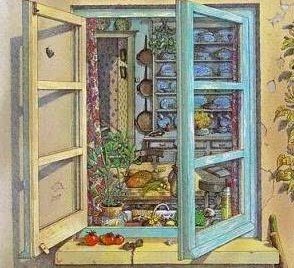 Kitchens are more than just a place to cook our food. They are usually one of the main family living areas where we gather, commune, play, break bread with family and friends, and sometimes even work with laptop and files plopped on the table so we are sure to stay abreast of all the family’s happenings.
Kitchens are more than just a place to cook our food. They are usually one of the main family living areas where we gather, commune, play, break bread with family and friends, and sometimes even work with laptop and files plopped on the table so we are sure to stay abreast of all the family’s happenings.
But they weren’t always this way. In fact, in the late 1700’s and throughout the 1800’s – kitchens were more or less viewed as necessary evils to be tolerated and tucked away as unseen, unfelt, unheard, and unknown as possible.
In the very earliest Colonial America houses, this was accomplished by building kitchens in the basement of homes to keep the hardworking class that worked in the kitchen, as well as all of a kitchen’s rubbish, odors, soot, and smoke as far from the dining and living areas as possible.
Somewhere in the beginning of the 1700’s, kitchens began to be removed from the home and housed in small buildings located a short distance from the main house – something we usually refer to as a “summer kitchen”. We’ve heard these kitchens were built to save the main house from the extra heat of a kitchen during the hot summer months.
This was, no doubt, a consideration, and probably the primary one for most households. But as it turns out, it’s not the only one, and probably not the primary one for more well-off households. This new kitchen architecture in wealthier households seems to have had more to do with race, gender, and social space than it did with the practical considerations of meal preparations for those in the middle to upper classes, as it reflected the growing custom of separating guests and family from slaves and cooks.
While energy efficiency was a dominant concern for one demographic in early America, and a strong sense of social order and place for another demographic, both demographics had one major reason for keeping kitchen spaces tucked away by the late 1700’s. In the 19th Century, the “Miasmatic Theory” was the dominant disease theory and promoted the belief that offensive odors of decaying materials transmitted diseases, and by the mid-1800’s experts were campaigning to eliminate the causes of foul smells from housing in order to improve public health.
But keeping a house cooler in the summer, keeping the help away from the family and guests, and keeping sickness at bay by not exposing the house to offensive odors weren’t the only things that helped shape the history of our kitchen architecture. The changing roles of women too.
Women played the role of providers of preventative medicine in their role as housewives, and the new focus on public health and disease prevention propelled women into a new role: domestic scientist. Early feminist leaders advocated the use of a scientific approach to home management, cookery, and kitchen maintenance – especially as it related to maintaining good health. The kitchen became viewed as a workshop to be designed and maintained for optimal work quality instead of the utilitarian “evil necessity” they had been as the housewife found that she had a higher calling in the battle against disease.
This new “professional housewife” had a new role, and needed a new kitchen environment to match. Kitchens were pulled back into the home and placed squarely into the center of family function, as housewives tackled kitchen tasks in this new professional and scientific manner.
And so the modern kitchen was born, as by the turn of the 20th Century the loss of domestic help and advances in time management and public sanitation techniques shaped a new kitchen architecture for America.

